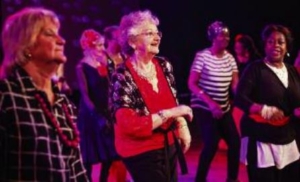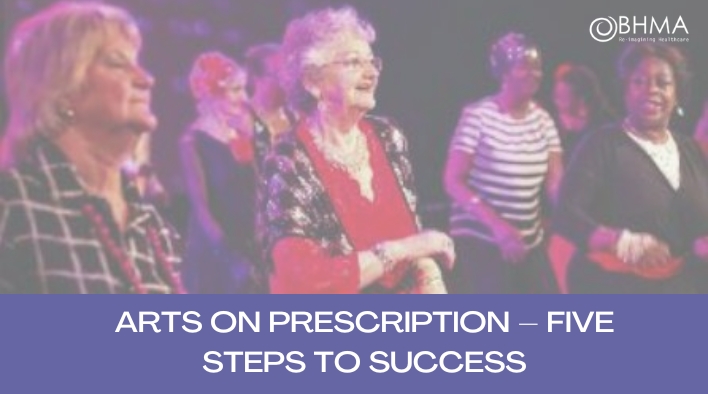Arts on prescription – five steps to success
Tim Joss– Chief Executive and founder of Aesop
Published in JHH15.3 – Social Prescribing
I’m a social entrepreneur. Looking back over the organisations and initiatives I led or founded,‘bridge building’ has been a common theme. Four years ago, I left the privileged position of directing one of the larger charitable foundations to found Aesop Aesop (arts enterprise with a social purpose) and play my part in connecting the arts world with other sectors including education, international development and criminal justice. Behind this stood a conviction that the arts have not realised their massive potential to improve the lives of people and communities.We decided that health would be the first focus.
A new bridge
Social prescribing creates a new bridge between health and the arts – arts on prescription as it is now known. As social prescribing grows, there is every chance that trust, confidence and collaborations between arts and health professionals will grow too, leading to many patients’ improved health and wellbeing.
Social prescribing offers an opportunity to leave behind the depressing conclusion of a major report of 2017. Creative Health, the result of a two-year inquiry commissioned by the All Party Parliamentary Group on Arts, Health and Wellbeing, found that ‘the United Kingdom is still very far from realising more than a small modicum of the potential contribution of the arts to health and wellbeing’.
Thanks to many energetic and imaginative people in health and the arts, things are moving now. Aesop’s contributions have included the first evaluation framework for arts and health (commissioned by Public Health England, 2016), two sell-out national arts and health showcases for health decision-makers in partnership with the College of Medicine, and a survey of health professionals’ attitudes to the arts. Aesop commissioned ComRes to survey more than 1,000 GPs. The results were heartening: 66% agreed that public engagement with the arts can make a significant contribution towards preventing ill[1]health among the public. 44% also agreed that arts-based interventions can be a cost-effective way to deliver primary care to the public and improve health outcomes. 62% agreed that art-based interventions can make a significant contribution to improving the health and wellbeing of NHS staff.
The big question now is how to make the most of this new momentum and the opportunities that social prescribing offers. Here are five recommended steps to arts on prescription’s success.
Step 1 – Build stronger communication, respect and understanding between health and the arts
These sectors think and do things differently.
Arts activity is project-based. Whether a community arts workshop or a Hollywood film, the activity is time-limited, of its time and place, and project-funded. Health activity on the other hand is service-based, aims to be universally available and requires sustainable funding.
Is this arts programme available in my area?’ is a common question asked by GPs. At present, almost all arts programmes are projects. No arts programme is universally available across the country.
Taking arts programmes to scale deserves to be a priority. There will be different ways of achieving this. It can mean delivery by one organisation such as National Museums Liverpool’s ‘House of Memories’ programme supporting people to live well with dementia, or by many collaborating such as the groups within the growing Dance for Parkinson’s UK Network.
On health sector attitudes to the arts, the Aesop survey of GPs generated more positive responses than expected. But for many in health the arts are treated as a ‘nice-to-have’ and ‘fluff’, not a core service. For instance, Norfolk and Norwich University Hospitals NHS Foundation Trust says on its website ‘All our [arts] projects are funded by grants from organisations and charitable donations, no money is taken from healthcare budgets’. This needs to change.
There is also a problem with arts sector attitudes to health. Arts professionals believe passionately in the transformative power of the arts but fear being ‘instrumentalised’. What they mean is a fear of being thought of as just additions to the health workforce, denied scope to be artistically creative and not respected as artists. Without this scope and respect, long-term engagement of artists will be a challenge.
This fear can be overcome. Aesop runs Dance to Health, a falls prevention dance programme for older people. The initial pilot programme showed that dance artists could be trained to smuggle evidence-based falls prevention exercises into creative, sociable dance activity and dance artists found the requirements artistically stimulating, not restrictive.
Developing a shared language will be crucial. Aesop’s latest contribution is the Active Ingredients Project, a collaboration with leading arts consultancy, BOP Consulting. It consciously draws on a health term and applies it to the arts, aiming to deepen our understanding of how arts interventions in health and social contexts actually work, and improve the ways these are designed and their impacts measured. The Active Ingredients model asserts that any wider utility of the arts is rooted in a core artistic and cultural experience. Those interested in the outcomes of arts in health need therefore to invest in that core artistic and cultural experience; it is not something that can be ‘value engineered’ out of the picture.
An example of an active ingredient is the arts’ ability to change the way someone thinks about themselves, moving them from a negative health identity to a positive artistic identity. As one Dance for Parkinson’s participant said, ‘I used to think of myself as someone with Parkinson’s. I now think of myself as a dancer’.
Step 2 – Harness passion and evidence
Approaches to evidence are very different in the arts and health. For example, while health has many widely used outcomes frameworks, the arts has none.
There are signs that convergence is under way. Social prescribing is one indication of health’s looking beyond the biomedical model. Public funding pressure, scrutiny and demands for accountability mean that passionate belief in the benefits of the arts is no longer enough. The Arts & Humanities Research Council’s Cultural Value Project is developing understanding of why the arts and culture matter and how we capture the effects that they have, and the evidence base for the arts achieving health improvement is growing.
However, more work is needed to bring research and practice closer together. The innovation foundation Nesta has made an important contribution with its standards of evidence (2013). There are five levels, progressing from ‘You can describe what you do and why it matters, logically, coherently and convincingly’ (Level 1) to ‘You can demonstrate causality using a control or comparison group’ (Level 3) to ‘You have manuals, systems and procedures to ensure consistent replication and positive impact’ (Level 5).
Step 3 – Develop standards and ethics
A link worker advising a patient on local arts opportunities must be confident that any chosen activity has suitable standards and ethics such as safeguarding policies and procedures. With small local groups, this will not always be the case.
There is limited evidence that artistic quality and health improvement go hand-in[1]hand. Encouragingly, Aesop’s experience with Dance to Health is that they do. It has been highly rewarding, effective and cost-effective to work with leading dance organisations already expert in working with older people.
More generally, measures for artistic quality are not established in the arts sector although Arts Council England has supported a quality metrics pilot which used self, peer and public assessment to capture the quality of art and cultural work.
Step 4 – Don’t make health inequalities worse
 In its ‘10 facts on health inequities and their causes’ the World Health Organization (2017) says, ‘There is ample evidence that social factors, including education, employment status, income level, gender and ethnicity have a marked influence on how healthy a person is. In all countries – whether low-, middle- or high[1]income – there are wide disparities in the health status of different social groups. The lower an individual’s socio[1]economic position, the higher their risk of poor health.
In its ‘10 facts on health inequities and their causes’ the World Health Organization (2017) says, ‘There is ample evidence that social factors, including education, employment status, income level, gender and ethnicity have a marked influence on how healthy a person is. In all countries – whether low-, middle- or high[1]income – there are wide disparities in the health status of different social groups. The lower an individual’s socio[1]economic position, the higher their risk of poor health.
As social prescribing link workers engage with their local communities they will find another inequality. A Third Sector Research Centre paper by Professor John Mohan (2011) concludes, ‘The broad picture is very clear: there are over 2.5 times as many organisations who say they work at the neighbourhood scale in the most prosperous neighbourhoods in the country compared to those in the most disadvantaged areas’.
Taken together, this means those with higher risk of poor health will have fewer social prescribing opportunities.
In the particular case of arts contributions to social prescribing, the inequalities may be even greater. Two reports by GPS Culture (2013, 2014) analysed distribution of arts funding. As Melvyn Bragg said in his endorsement ‘This report is timely, urgent and damning of an increasingly centralised funding process. London is simply eating up the resources, which are limited, and is there[1]fore starving the rest of the country. This is wrong, short sighted and undoubtedly unfair’.
The answer has already been recognised by the social prescribing movement: health must invest in social prescribing in disadvantaged communities. In the case of the arts, this can be helped by arts/health funding partnerships.
Step 5 – Don’t underestimate the power of the arts
We have a world class arts sector built on three big pillars: the creative industries such as book publishing and the music and film industries; the voluntary arts sector with over 49,000 groups and 9.4 million people taking part; and the publicly funded sector which widens access and invests in innovation and the national’s cultural heritage.
Fulfilling the arts’ potential to contribute to social prescribing is just base camp. The arts can go much further in support of health. Aesop’s national showcases have featured arts programmes which can be more effective and cost-effective than existing health provision – for example, the Raw Sounds music programme for aiding the rehabilitation of young people with severe mental illness. The arts have an important contribution to make to medical training as the Clod Ensemble’s Performing Medicine programme (www.clodensemble.com/learning/ performing-medicine/) has shown. And by helping patients express their experience of treatment (artist Bobby Baker’s Diary Drawings – https://dailylifeltd.co.uk/ our-work/diary-drawings for example), the arts help the health system reflect on how to humanise and improve its services.
References
- All Party Parliamentary Group on Arts, Health & Wellbeing (2017) Inquiry Report – Creative Health: The Arts for Health and Wellbeing. Available at:www.artshealthandwellbeing.org.uk/appg-inquiry/ Publications/Creative_Health_Inquiry_Report_2017_-_Second_ Edition.pdf (accessed 3 September 2018).
- Mohan J (2011) Mapping the Big Society: perspectives from the Third Sector Research Centre. Available at: www.birmingham.ac.uk/generic/ tsrc/documents/tsrc/working-papers/working-paper-62.pdf (accessed 3 September 2018).
- Nesta (2013) Standards of Evidence. [Online]. Available at: https://bit.ly/2pkop6t (accessed 3 September 2018).
- Public Health England (2016) Arts for health and wellbeing: an evaluation framework. London: Public Health England.
- Stark P, Gordon C, Powell D (2014) GPS Culture (2014) Policy for the lottery, the arts and community in England. Available at: www.gpsculture.co.uk/place.php (accessed 3 September 2018).
- Stark P, Gordon C, Powell D (2013) Rebalancing our cultural capital. GPS Culture [online]. Available at: http://www.gpsculture.co.uk/down[1]loads/rocc/Rebalancing_FINAL_3mb.pdf (accessed 3 September 2018).
- World Health Organization (2017) 10 facts on health inequities and their causes. Geneva: WHO. Available at: www.who.int/features/ factfiles/health_inequities/en (accessed 3 September 2018).








